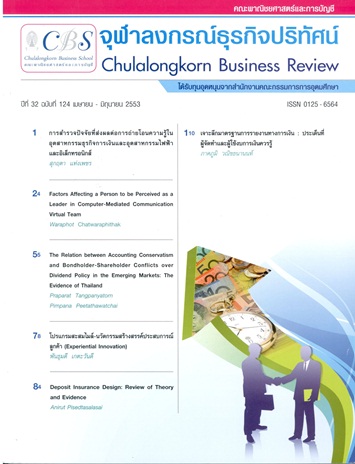Deposit Insurance Design: Review of Theory and Evidence
Main Article Content
Abstract
บทคัดย่อ
บทความวิชาการชิ้นนี้ประมวลทฤษฏีและหลักฐานเชิงประจักษ์ ที่เกี่ยวข้องกับรูปแบบของระบบคุ้มครองเงินฝากในประเทศต่างๆทั่วโลกรวมทั้งประเทศไทย ซึ่งงานวิจัยที่ผ่านมาโดยส่วนใหญ่ชี้ให้เห็นว่าประโยชน์ที่ได้รับจากการระบบคุ้มครองเงินฝากจะถูกบั่นทอน ถ้าไม่มีการวางรูปแบบระบบคุ้มครองเงินฝากที่เหมาะสมควบคู่ไปกับการกำกับดูแลทีดีโดยสถาบันคุ้มครองเงินฝาก เพื่อลดผลกระทบด้านลบที่เกิดขึ้นจากระบบคุ้มครองเงินฝาก
จากการศึกษาระบบคุ้มครองเงินฝากของไทย ตาม พ.ร.บ. สถาบันคุ้มครองเงินฝาก ปี พ.ศ. 2551 พบว่า ระบบคุ้มครองเงินฝากของไทยมีจำนวนเงินคุ้มครอง (coverage limit) อยู่ในเกณฑ์ที่สูงเมื่อเทียบกับนานาประเทศ โดยเฉพาะกลุ่มประเทศที่มีรายได้สูงและรายได้ระดับกลางค่อนข้างสูง นอกจากนั้นผู้ฝากสามารถเพิ่มจำนวนความคุ้มครองได้อีกหลายเท่าตัวโดยการฝากเงินไว้กับธนาคารหลายๆแห่ง ซึ่งการคุ้มครองเงินฝากในระดับสูงจะก่อให้เกิดผลเสียต่อระบบธนาคารมากกว่าประโยชน์ที่จะได้รับ ดังนั้นในระยะยาว ผู้วางนโยบายควรลดจำนวนเงินคุ้มครองให้อยู่ในระดับที่เหมาะสม และควรเปลี่ยนระบบการจัดเก็บเงินส่งเข้ากองทุนให้แปรผันตามความเสี่ยงของสถาบันการเงิน (risk-adjusted premium system) และเพิ่มระบบการประกันร่วม (co-insurance system) เข้ามาด้วย เพื่อควบคุมผลเสียที่จะเก็ดขึ้นจากการมีระบบคุ้มครองเงินฝาก
ส่วนผลกระทบของระบบคุ้มครองเงินฝากที่อาจมีต่อระบบธนาคารพาณิชย์และตลาดการเงิน ในระยะสั้นคาดว่ามีผลกระทบค่อนข้างน้อย แต่ในระยะยาวคาดว่าระบบคุ้มครองเงินฝากจะมีผลกระทบโดยตรงต่อต้นทุนของธนาคารและความสามารถในการแข่งขันของธนาคาร ซึ่งธนาคารที่มีการบริหารความเสี่ยงที่ดี จะมีความสามารถในการแข่งขันที่สูงกว่าและมีต้นทุนที่เกี่ยวเนื่องที่ต่ำกว่า ซึ่งจะเป็นแรงผลักดักให้ธนาคารพาณิชย์พยายามที่จะบริหารความเสี่ยงของตนให้มีประสิทธิภาพยิ่งขึ้น
Abstract
This article reveals various design features of deposit insurance schemes across countries and discusses how these design features can help to curb adverse effects on banking stability and development created by introducing deposit insurance schemes. Evidence suggests that the benefits of deposit insurance will be undermined if insurance schemes are not properly designed and accommodated by strong institutional environment, tough regulation and enforcement.
For the new deposit insurance scheme in Thailand, under the Institue of Deposit Protection Act 2008 that is postponed to be enforced in August 2011, overall the scheme offers considerably higher coverage limits relative to high and upper-middle income countries. Moreover, the actual coverage amounts can be even much larger since this coverage limit will be applied on the basis of per institution per account. Therefore, in the long term it is crucial for policy makers and banking regulators to lower the coverage limit and alter the extent of coverage. Other recent design features such as risk premium and co-insurance systems are also needed to be considered since they seem to be an effective means for controlling adverse effects arising from the deposit insurance by limiting risk-taking behaviors of banks and increasing incentives for market to discipline banks.
The immediate impact of the new deposit insurance scheme on the banking system in Thailand is likely to be minimal. However, in the long term, this deposit insurance scheme could potentially increase operating costs and lower competiveness for banks with high risk, relative to low-risk banks. Therefore, to maintain or increase the competitiveness, banks will be actively forced to improve their risk profile.
Article Details
Opinions and discussions in papers published by the Creative Business and Sustainability Journal (CBSJ) are deemed as personal opinions and the responsibility of the writers. They are not the opinions or responsibility of the Chulalongkorn Business School of Chulalongkorn University.
Papers, content, information etc. appearing in the Journal are deemed to be the copyright property of the Chulalongkorn Business School of Chulalongkorn University. Anybody or any organization that wishes to publish any part of them or use them in any way must obtain written permission from the Chulalongkorn Business School, Chulalongkorn University.


